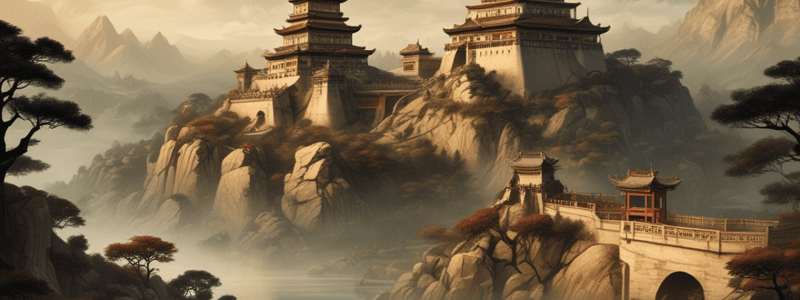Podcast
Questions and Answers
What is a significant advantage of China's natural barriers?
What is a significant advantage of China's natural barriers?
- Access to the sea
- A diverse geography
- Protection from invaders (correct)
- Easier trade with other early civilizations
Which mountain range runs across the southwestern part of China?
Which mountain range runs across the southwestern part of China?
- The Kunlun Mountains
- The Qinling Mountains
- The Himalayan Mountains (correct)
- The Tianshan Mountains
What is a disadvantage of China's natural barriers?
What is a disadvantage of China's natural barriers?
- They made the climate colder
- They created four distinct regions
- They provided a route for invaders
- They prevented trade with other early civilizations (correct)
What can be said about Ancient China's geography?
What can be said about Ancient China's geography?
What is the highest peak in the Himalayan Mountains?
What is the highest peak in the Himalayan Mountains?
What can be said about the four distinct regions of Ancient China?
What can be said about the four distinct regions of Ancient China?
What two rivers are mentioned as being protected by natural barriers?
What two rivers are mentioned as being protected by natural barriers?
What is the location of the Hainan Province in China?
What is the location of the Hainan Province in China?
What is the primary purpose of the natural barriers surrounding Ancient China?
What is the primary purpose of the natural barriers surrounding Ancient China?
What is unique about the Gobi Desert compared to other deserts?
What is unique about the Gobi Desert compared to other deserts?
What is the primary reason for the limited use of the Tibetan Tundra?
What is the primary reason for the limited use of the Tibetan Tundra?
What is the primary crop grown in the river valley regions of central China?
What is the primary crop grown in the river valley regions of central China?
What is the purpose of the laws set in place to protect Hainan Island?
What is the purpose of the laws set in place to protect Hainan Island?
What is the geological feature that separates the East Sea and the South Sea?
What is the geological feature that separates the East Sea and the South Sea?
What is the climate like in the Gobi Desert?
What is the climate like in the Gobi Desert?
Flashcards are hidden until you start studying
Study Notes
Natural Barriers
- China's geography features natural barriers that acted as a protective layer against foreign invasions.
- The Himalayas, the highest mountain range in the world, run across the southwestern region of China.
- The disadvantage of these natural barriers was that they isolated Ancient China, hindering communication and cultural exchange.
Ancient China's Geography
- Ancient China's geography was influenced by its four distinct regions: the North China Plain, the Yangtze River Valley, the South China Sea, and the Tibetan Plateau.
- The North China Plain supported large-scale agriculture due to fertile soil and access to the Yellow River (Huang He).
- The Yangtze River Valley, home to the Yangtze River, provided fertile land, abundant water resources, and a trade route connecting the north and south.
- The South China Sea, with its coastline and numerous islands, facilitated trade and cultural exchange with other regions.
- The Tibetan Plateau, a vast, high-altitude region, provided access to important resources, including water and minerals.
Key Features
- The Himalayas, with Mount Everest as its highest peak, created significant natural barriers.
- The Yellow (Huang He) and Yangtze rivers, protected by natural barriers, played pivotal roles in irrigating land and providing transportation routes.
- The Hainan Province, located off the coast of southern China, is an island province with unique biodiversity.
- The Gobi Desert, a cold desert located in the north of China, is unique for its arid climate and lack of vegetation.
- The Tibetan Tundra, situated on the Tibetan Plateau, features harsh, cold conditions, limiting its agricultural use.
Protection and Climate
- Hainan Island's laws protect its ecosystem and biodiversity.
- The East Sea and the South Sea are separated by the Taiwan Strait, a geological feature formed by tectonic activity.
- The Gobi Desert has a cold, arid climate, characterized by extreme temperature variations between day and night.
- Rice is the primary crop grown in the river valley regions of central China.
- The primary function of the natural barriers surrounding Ancient China was to defend against invasions, isolate the region, protect trade routes, and preserve cultural identity.
Studying That Suits You
Use AI to generate personalized quizzes and flashcards to suit your learning preferences.



